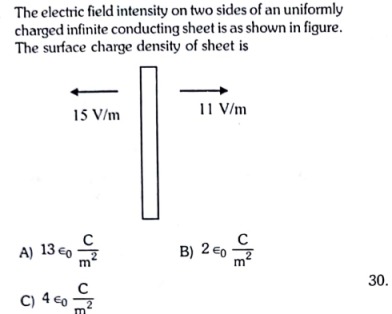Question
Question: The electric field intensity on two sides of an uniformly charged infinite conducting sheet is as sh...
The electric field intensity on two sides of an uniformly charged infinite conducting sheet is as shown in figure. The surface charge density of sheet is

A
13ϵ0m2C
B
2ϵ0m2C
C
4ϵ0m2C
Answer
Option C 4ϵ0m2C
Explanation
Solution
For an isolated conducting sheet in an external field, the net electric fields just outside on the two sides can be written as
Eleft=E0+2ϵ0σandEright=E0−2ϵ0σ,where E0 is the external field. The conductor is an equipotential so the difference in the net fields is solely due to the discontinuity caused by the surface charge. Thus, subtracting the two equations we have
Eright−Eleft=−ϵ0σ.Taking magnitudes (and noting that the directions of the fields are oppositely directed),
∣Eright−Eleft∣=ϵ0σ.Given that the field magnitudes are 15 V/m and 11 V/m, we get
15−11=ϵ0σ⟹4=ϵ0σ.Therefore,
σ=4ϵ0(m2C).Thus, the correct option is C) 4ϵ0m2C.
